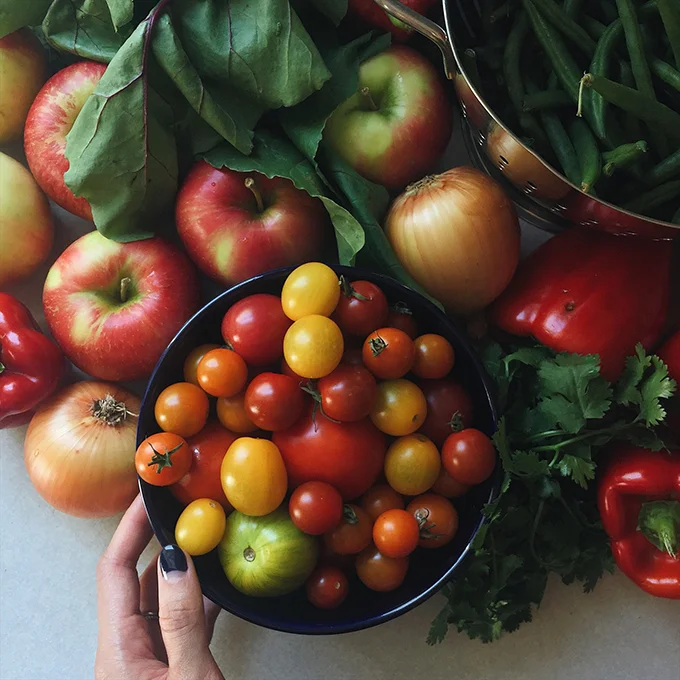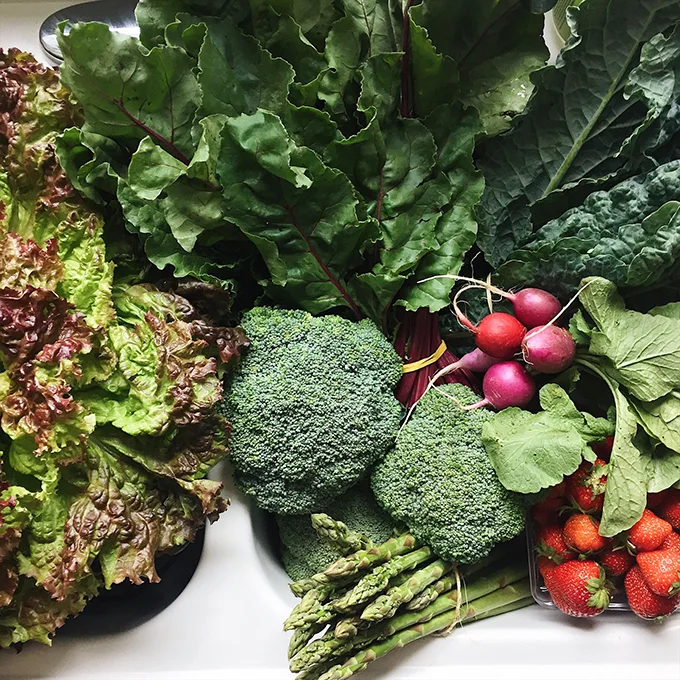Why You Should Join a CSA
Tomatoes and mani on point.
Unless you grow your own food or make weekly trips to a farmers market you may be hard pressed to find quality, fresh produce at your local grocery store in the summer. Large chains tend to have the saddest choices: yellowing herbs, wilted greens, under-ripe everything – all from far flung places.
But that doesn’t mean you have to settle for what a grocery store has to offer! If organic, locally sourced, in-season produce is important to you, consider signing up for community shared agriculture (CSA).
Read on to learn more about what to expect from a CSA and why you should consider joining one.
What is a CSA?
Basically, you invest in a share of a local farm before the season begins. In exchange, you share the risk and bounty from the growing season. Then you pick up a “box” of whatever was harvested according to a schedule: ours was a weekly pick up, but the farm also offered every other week and some farms have monthly options.
Most farms do vegetable shares, but there may be some in your area that include eggs, meat, or dairy.
Sometimes there are choices to make at pickup (i.e.: one bunch radishes or beets? 1 cabbage or kohlrabi?), but mostly it’s a fun surprise and an excellent way to eat with the season while supporting a local farm.
We participated in a CSA with Groundswell Community Farm and I wish we joined sooner! More on that below.
Why should I join a CSA?
You’re supporting a local farmer
Do we need any more reasons to support our local communities vs. a mega grocery chain? Your investment helps the farm gather resources and focus on growing their best produce. Support local whenever possible, especially farmers who are doing things right. No farms, no food!
You’re getting farm fresh, nutrient dense produce
If you don’t have time to grow your own veg or to grab a weekly haul at your farmers market, this makes healthy produce shopping easy. You’ll get to know how and where your food was grown and the people who make it all happen.
Beautiful heirlooms at our CSA pickup!
You’ll know what is in season
We’ve become accustomed to having “fresh” tomatoes in November and asparagus in February – but that doesn’t mean we should! Those veggies were grown thousands of miles away, harvested before their time, and sat on trucks for days before reaching their final destination.
Long travel time for conventionally grown produce = less nutrients. Our ancestors ate with the seasons, and we should too.
You’ll try something new
Yeah, I’m counting this as an advantage! Trying new food pushes us out of our comfort zone and growth is a good thing.
Not sure how to cook something? Google that shit. I took to YouTube when we had piles of garlic scapes – no shame! And no excuses.
- Here are some tips on how to get more out of your CSA.
- I’m looking forward to learning how to can next season. Until then there’s still pesto in the freezer.
You’ll save money in the long run
A CSA share is no small investment, but spread over an entire season you actually pay less for organic produce than if you were to buy the same items at the grocery store or farmers market.
From a health standpoint, I believe that food is medicine and I don’t mind cutting other areas of our budget to eat nutrient dense food. I’d rather eat fresh produce over ineffective artificially dyed and sweetened vitamins any day.
What are the downsides of a CSA?
In the spirit of keeping this balanced, here are some challenges to participating in a CSA.
It’s an investment
While a CSA can save money in the long run, some may feel that the up-front investment is an obstacle. If cost is a concern, try splitting a share with family or friends.
You could also do a half-share if that is available through your local farm. Ask about share options and if payment plans are available.
You have a set time and place to pick up your share.
We picked up our CSA box between 4:30PM and 6:30PM at our local farmers market every Wednesday. If we missed a pickup, we missed a share. I confess this happened once – the last week of our summer share when I forgot to make arrangements. (Ugh)
I feel a little less guilty knowing that our CSA donates forgotten shares!
Setting up a recurring event on Google calendar with reminder notifications helped me remember to pick up our share. For the weeks I was out of town my mother-in-law grabbed our box.
The box can be a bit of a surprise
I get it, not knowing what’s in the box (insert Brad Pitt in Se7en here) can throw a wrench in your meal prep game.
Our CSA sent a weekly newsletter with a best guess for the upcoming share that was a helpful resource. I adjusted my #grocerycrawl and meal prep around the Wednesday pick up and it worked out just fine.
I still went to the farmers market to make supplementary purchases, but it became my favorite part of my Saturday morning routine.
Try before you buy: Groundswell Community Farm offers a “CSA for a Day” box at the Saturday farmers market for anyone who is curious about what might come in a weekly haul.
- Check out my What’s in the CSA Box? series to see what we received in our June and July boxes AND how we used it!
- See a 2016 share breakdown from Groundswell Community Farm
Don't forget to save your beet greens!
It’s a LOT of food
I hate wasting food! I admit there were a couple of weeks some produce wilted or spoiled because I didn’t meal plan accordingly and I still kick myself. This is where sharing with family or friends is super helpful.
It DOES take time to wash, dry, and store a weekly haul, but it’s well worth the convenience later to have everything ready to go. Think of it as fridge mise en place – and we all want to win that fridge Tetris game.
I reserved Wednesday evenings as grocery and meal prep day and caught up on podcasts while I cleaned and stored our veggies.
- This salad spinner was a lifesaver. I’ve often seen them for $10 at Homegoods too!
- Love these tips on how to wash and store leafy greens!
Tip: Use a salad spinner for clean, crisp greens!
How much does a CSA cost?
A full summer CSA share is an investment to make in one go, but rest assured you are investing in a local farmer and in your health.
After all, would you rather pay the farmer now or the doctor later?
Organically grown produce is fresh, in season, and higher in polyphenols.
In 2017 we paid $453 for a full, 22 week summer share that ran June through October. This broke down to about $21 per week, but the estimated value was often between $30 and $50 for each box. Win! We would have paid a lot more had we sought the same organic produce from our local grocery store or farmers market.
Some farms even offer a half-share / every other week pickup if weekly pickup is too much for your household.
Our weekly box was more than enough for two people, and we eat a TON of produce! When tomato season was in full swing we shared plenty with family and friends.
Where can I find a CSA?
If you live in the Grand Rapids or West Michigan area, I highly recommend checking out Groundswell Community Farm! They hold down the last stall at the Fulton St. Farmers Market in Grand Rapids on Saturdays (at least until end of November). I was drawn to their beautiful spread, especially this obscenely large lettuce, colorful radishes, and lush herb bunches.
This was my haul from my first encounter with Groundswell Community Farm. The lettuce was MASSIVE.
All of their produce is certified organic and they don’t spray. Sometimes I found a caterpillar friend in my produce but, honestly, I’d rather have a buddy on my produce than toxic chemicals. ¯\_(ツ)_/¯
They grow more than 100 varieties of vegetables at their farm in Zeeland and can be found at Fulton St. Farmers Market and Zeeland market for most of spring-winter!
If you live outside of Grand Rapids, MI check out your local farmers market in the spring. Farms that offer a CSA share will usually start advertising summer sign-up opportunities at that time.
You can also check out the Local Harvest database or simply Google “CSA” + your city.
Have you participated in a CSA? If so, how did you make the most out of it?





